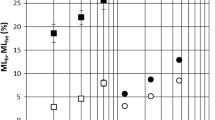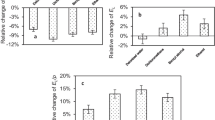Abstract
Extractives can affect the vibrational properties tanδ (damping coefficient) and E′/ρ (specific Young’s modulus), but this is highly dependent on species, compounds, and cellular locations. This paper investigates such effects for African Padauk (Pterocarpus soyauxii Taub.), a tropical hardwood with high extractives content and a preferred material for xylophones. Five groups of 26 heartwood specimens with large, yet comparable, ranges in vibrational properties were extracted in different solvents. Changes in vibrational properties were set against yields of extracts and evaluation of their cellular location. Methanol (ME) reached most of the compounds (13%), located about half in lumen and half in cell-wall. Water solubility was extremely low. tanδ and E′/ρ were very strongly related (R 2 ≥ 0.93), but native wood had abnormally low values of tanδ, while extraction shifted this relation towards higher tanδ values. ME extracted heartwood became in agreement with the average of many species, and close to sapwood. Extractions increased tanδ as much as 60%, irrespective of minute moisture changes or initial properties. Apparent E′/ρ was barely changed (+2% to −4%) but, after correcting the mass contribution of extracts, it was in fact slightly reduced (down to −10% for high E′/ρ), and increasingly so for specimens with low initial values of E′/ρ.






Similar content being viewed by others
References
Ajuong EA, Breese M (1997) The role of extractives on short-term creep in compression parallel to the grain of Pai wood (Afzelia africana Smith). Wood Fiber Sci 29:161–170
Akitsu H, Gril J, Norimoto M (1993) Uniaxial modelling of vibrational properties of chemically modified wood. Mokuzai Gakkaishi 39:258–264
Aramaki M, Baillères H, Brancheriau L, Kronland-Martinet R, Ystad S (2007) Sound quality assessment of wood for xylophone bars. J Acoust Soc Am 121:2407–2421
Bariska M, Pizzi A (1986) The interaction of polyflavonoid tannins with wood cell walls. Holzforschung 40:299–302
Brémaud I (2006) Diversity of woods used or usable in musical instruments making. Experimental study of vibrational properties in axial direction of contrasted wood types mainly tropical and relationships to features of microstructure and secondary chemical composition. (in French). PhD. In mechanics of materials. Université Montpellier II
Brémaud I, Cabrolier P, Gril J, Clair B, Gérard J, Minato K, Thibaut B (2010) Identification of anisotropic vibrational properties of Padauk wood with interlocked grain. Wood Sci Technol (under review)
Cardon D (2007) Natural dyes: sources, tradition, technology and science. Archetype Publications, London, p 778
Chafe C (1987) Collapse, volumetric shrinkage, specific gravity and extractives in Eucalyptus and others species. Part II: the influence of wood extractives. Wood Sci Technol 21:27–41
Déon G, Chadenson M, Hauteville M (1980) Influence des extraits naturels du bois sur sa résistance à la pourriture. Bois et Forêts des Tropiques 191:75–90
Gérard J (1991) Gutta Percha Ironwood et Lancewood. Trois nouveaux bois précieux nord-Australiens. Un exemple de sélection technologique et de promotion d’essences secondaires tropicales. Bois et Forêts des Tropiques 228:63–73
Hernandez RE (2007) Moisture sorption properties of hardwoods as affected by their extraneous substances, wood density, and interlocked grain. Wood Fiber Sci 39:132–145
Kuo ML, Arganbright DG (1980) Cellular distribution of extractives in redwood and incense cedar. Part I. Radial variation in cell-wall extractive content. Holzforschung 34:17–22
Lange W, Faix O (1999) Lignin-polyphenol interaction in Azobe (Lophira alata) heartwood. A study on milled wood lignin (MWL) and klason residues. Holzforschung 53:519–524
Luxford RF (1931) Effects of extractives on the strength of wood. J Agric Res 42:801–826
Mantanis GI, Young RA, Rowell RM (1994) Swelling of wood. Part II. Swelling in organic liquids. Holzforschung 48:480–490
Mantanis GI, Young RA, Rowell RM (1995) Swelling of wood. Part III. Effect of temperature and extractives on rate and maximum swelling. Holzforschung 49:239–248
Matsunaga M, Minato K, Nakatsubo F (1999) Vibrational property changes of spruce wood by impregnation with water-soluble extractives of pernambuco (Guilandina echinata Spreng.). J Wood Sci 45:470–474
Minato K, Sakai K, Matsunaga M, Nakatsubo F (1997) The vibrational properties of wood impregnated with extractives of some species of Leguminosae. Mokuzai Gakkaishi 43:1035–1037
Minato K, Konaka Y, Brémaud I (2007) Vibrational properties of Padauk (Pterocarpus soyauxii) and Muirapiranga (Brosimum sp.) related to their extractives (in Japanese). August 8–10, 2007, Hiroshima, Japan. 57th annual meeting of the Japan Wood Research Society. Paper N°M08-1030
Minato K, Konaka Y, Brémaud I, Suzuki S, Obataya E (2010) Extractives of muirapiranga (Brosimum spp.) and its effects on the vibrational properties of wood. J Wood Sci 46:41–46
Morgan JWW, Orsler RJ (1969a) The interaction of wood with organic solvents. Part I. The swelling behaviour of beech and podo with some common solvents. Holzforschung 23:1–5
Morgan JWW, Orsler RJ (1969b) The interaction of wood with organic solvents. Part II. Its significance for extractive location. Holzforschung 23:48–51
Obataya E, Norimoto M, Gril J (1998) The effects of adsorbed water on dynamic mechanical properties of wood. Polymer 39:3059–3064
Obataya E, Umezawa T, Nakatsubo F, Norimoto M (1999) The effects of water-soluble extractives on the acoustic properties of reed (Arundo donax L.). Holzforschung 53:63–67
Obataya E, Minato K, Tomita B (2001) Influence of moisture content on the vibrational properties of hematoxylin-impregnated wood. J Wood Sci 47:317–321
Ono T, Norimoto M (1983) Study on Young’s modulus and internal friction of wood in relation to the evaluation of wood for musical instruments. Jpn J Appl Phys 22:611–614
Sakai K, Masahiro M, Minato K, Nakatsubo F (1999) Effects of impregnation of simple phenolics and natural polycyclic compounds on physical properties of wood. J Wood Sci 45:227–232
Sugiyama M, Matsunaga M, Minato K, Norimoto M (1994) Physical and mechanical properties of pernambuco (Guilandina echinata Spreng) used for violin bows. Mokuzai Gakkaishi 40:905–910
Surowiec I, Nowik W, Trojanowicz M (2004) Indentification of “insoluble” red dyewoods by high performance liquid chromatography-photodiode array detection (HPLC-PDA) fingerprinting. J Sep Sci 27:209–216
Wangaard FF, Granados LA (1967) The effect of extractives on water-vapor sorption by wood. Wood Sci Technol 1:253–277
Yano H (1994) The changes in the acoustic properties of western red cedar due to methanol extraction. Holzforschung 48:491–495
Yano H, Kyou K, Furuta Y, Kajita H (1995) Acoustic properties of Brazilian rosewood used for guitar back plate (in Japanese). Mokuzai Gakkaishi 41:17–24
Acknowledgments
The authors appreciate the help of C. Baudassé and N. Leménager in CIRAD. This work has been supported by a Post-Doctoral Fellowship from Japanese Society for the Promotion of Science.
Author information
Authors and Affiliations
Corresponding author
Rights and permissions
About this article
Cite this article
Brémaud, I., Amusant, N., Minato, K. et al. Effect of extractives on vibrational properties of African Padauk (Pterocarpus soyauxii Taub.). Wood Sci Technol 45, 461–472 (2011). https://doi.org/10.1007/s00226-010-0337-3
Received:
Published:
Issue Date:
DOI: https://doi.org/10.1007/s00226-010-0337-3




